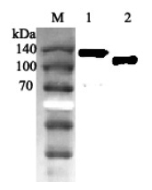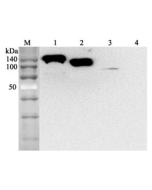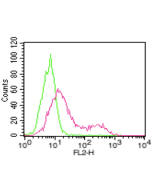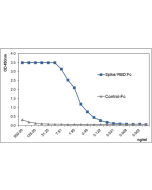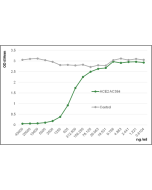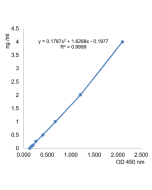Cookie Policy: This site uses cookies to improve your experience. You can find out more about our use of cookies in our Privacy Policy. By continuing to browse this site you agree to our use of cookies.
AdipoGen Life Sciences
anti-ACE2 (human), mAb (AC384) (Biotin)

1: Human ACE2 Fc-fusion protein.
2: Human ACE2 (Ecto domain) (FLAG®-tagged).
3: HepG2 cell lysate.
4: Other Fc-fusion (hGITR-Fc) proteins (negative control).
| Product Details | |
|---|---|
| Synonyms | SARS Receptor; Angiotensin-converting Enzyme 2; ACEH; Metalloprotease MPROT15; SARS-CoV-2 Receptor |
| Product Type | Monoclonal Antibody |
| Properties | |
| Clone | AC384 |
| Isotype | Mouse IgG1κ |
| Immunogen/Antigen | Recombinant human ACE2. |
| Label/Conjugates | Biotin |
| Application |
ELISA: (direct or indirect: 1:2'000-1:10'000) |
| Crossreactivity | Human |
| Specificity |
Recognizes human ACE2. |
| Purity Detail | Protein G-affinity purified. |
| Concentration | 1mg/ml |
| Formulation | Liquid. 0.2μm-filtered solution in PBS, pH 7.4. Contains no preservatives. |
| Isotype Negative Control | |
| Shipping and Handling | |
| Shipping | BLUE ICE |
| Short Term Storage | +4°C |
| Long Term Storage | -20°C |
| Handling Advice |
After opening, prepare aliquots and store at -20°C. Avoid freeze/thaw cycles. |
| Use/Stability | Stable for at least 1 year after receipt when stored at -20°C. |
| Documents | |
| MSDS |
 Download PDF Download PDF |
| Product Specification Sheet | |
| Datasheet |
 Download PDF Download PDF |
Angiotensin-converting enzyme2 (ACE2) is an ectoenzyme (carboxypeptidase) with an extracellular catalytic domain that predominantly localizes at the plasma membrane and is thereby able to hydrolyze circulating peptides. ACE2 has approximately 42% sequence identity with ACE, and its cytoplasmic and transmembrane domains show 48% homology to the protein collectrin that plays a critical role in the amino acid absorption of the kidney. ACE2 converts angiotensin I to angiotensin 1-9, a peptide of unknown function, and angiotensin II to angiotensin 1-7, a vasodilator. ACE2 is involved in the regulation of systemic blood pressure and has direct effects on cardiac functions. It is expressed predominantly in endothelial cells of the lung, gut, heart and kidney. ACE2 together with the protease TMPRSS2 acts as a functional receptor for SARS coronavirus as well as for the new highly pathogenic coronavirus, 2019-nCoV/SARS-CoV-2, which is cause for pneumonia COVID-19.
- Development of an enzymatic assay for the detection of neutralizing antibodies against therapeutic angiotensin-converting enzyme 2 (ACE2): K. Liao, et al.; J. Immunol. Meth. 389, 52 (2013)
- Role of angiotensin-converting enzyme 2 (ACE2) in diabetic cardiovascular complications: VB. Patel, et al.; Clin. Sci. 126, 471 (2014)
- Stapled Peptides Based on Human Angiotensin-Converting Enzyme 2 (ACE2) Potently Inhibit SARS-CoV-2 Infection In Vitro: F. Curreli, et al.; mBio 11, e02451 (2020)
- Pomegranate Peel Extract as an Inhibitor of SARS-CoV-2 Spike Binding to Human ACE2 Receptor (in vitro): A Promising Source of Novel Antiviral Drugs: A. Tito, et al.; Front. Chem. 9, 638187 (2021)
- Relevance of VEGF and CD147 in different SARS‐CoV‐2 positive digestive tracts characterized by thrombotic damage: D. Bortolotti, et al.; FASEB J. 35, e21969 (2021)
- SARS-CoV-2 Spike Protein 1 Activates Microvascular Endothelial Cells and Complement System Leading to Platelet Aggregation: L. Perico, et al.; Front. Immunol. 13, 827146 (2022)
- Discovery of Highly Potent Fusion Inhibitors with Potential Pan-Coronavirus Activity That Effectively Inhibit Major COVID-19 Variants of Concern (VOCs) in Pseudovirus-Based Assays: F. Curreli, et al.; Viruses 14, 69 (2022)
- SARS-CoV-2 infects epithelial cells of the blood-cerebrospinal fluid barrier rather than endothelial cells or pericytes of the blood-brain barrier: C. Stuedle, et al.; Fluids and Barriers of the CNS 20, 76 (2023) [Immunofluorescence]
- Evolutionary dynamics of heparan sulfate utilization by SARS-CoV-2: S. Higuchi, et al.; mBio 16, e0130325 (2025) [Flow Cytometry]






